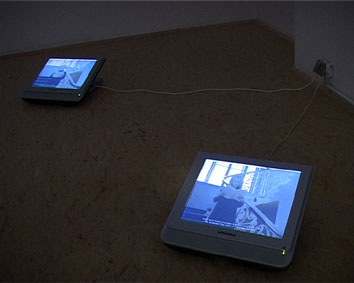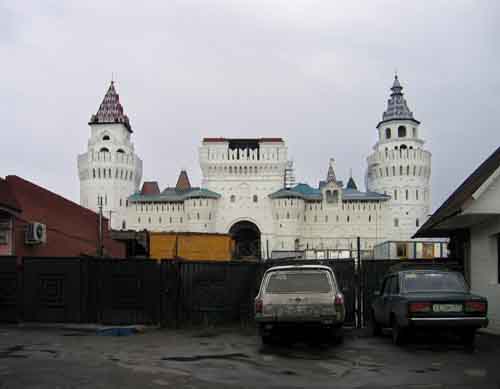Gülsen Bal and “Open Space” at the Zentrum für Kunstprojekte, Vienna
Open Space, Zentrum für Kunstprojekte, Lassingleithnerplatz 2 Schwedenplatz, A – 1020 Vienna, Austria.
With the inauguration of “Open Space” by Gülsen Bal at the beginning of 2008, Vienna’s art scene saw an important enrichment of exhibition space after a number of crisis-ridden institutional changes in 2007. The merger of Generali and Bawag Foundation into one exhibition space saw the end of a decade-long exhibition program concerned with a stringent focus on conceptual practices. The latter abruptly came to a halt due to the decisions made by the groups’ CEOs, which demonstrated how global capital dominates artistic representation and its social reverberations.
With the initiation with “Open Space”, Bal exactly confronts this onslaught of capitalist-driven exhibition projects with a space in Vienna’s second district where alternative music and art venues like Fluc have moved in recent years. There with her first exhibition project, “Temporary Zones,” Bal points at the fluctuation of artistic spaces and practices and their potential to intervene into dominant social structures. Three works testify to the notion of what it means to live in spatial environments that are constantly subject to change, especially with regard to the formation of a New Europe and the mechanisms of inclusion and exclusion. Walking into a basement-like space opens up the frontiers with which we are confronted on a daily basis but which cannot be eradicated from daily life.
 London-based artist Nada Prlja from Bosnia presents a video in which children read from the European Convention for the Protection of Human Rights and Fundamental Freedom, which enforces a heightened awareness of this legal text that is especially difficult to read for children. How can the transition to a New Europe be lived when the basic rights of freedom, migration, and a solid income are not guaranteed? The speakers and subjects of enunciation are children from Macedonia, Romania, Turkey and Serbia, a future generation of European citizens who are not yet able to grasp what their future life could be. Thus, the transition from their mindset to that of a legal body marks the cultural threshold addressed in Prlja’s video. It is the fortress of Europe which stands in-between what is legally possible and culturally feasible.
London-based artist Nada Prlja from Bosnia presents a video in which children read from the European Convention for the Protection of Human Rights and Fundamental Freedom, which enforces a heightened awareness of this legal text that is especially difficult to read for children. How can the transition to a New Europe be lived when the basic rights of freedom, migration, and a solid income are not guaranteed? The speakers and subjects of enunciation are children from Macedonia, Romania, Turkey and Serbia, a future generation of European citizens who are not yet able to grasp what their future life could be. Thus, the transition from their mindset to that of a legal body marks the cultural threshold addressed in Prlja’s video. It is the fortress of Europe which stands in-between what is legally possible and culturally feasible.
The same applies to Peter Mörtenböck’s and Helge Mooshammer’s photo series Visiting Stalin, which traces the current development of the former Stalin arena in Moscow. This former sports stadium has been turned into an empty signifier called Cherkizovsky Market, where migrants from Uzbekistan, Chechnya and the Middle East try to make a living with jobs that barely guarantee a decent existence. Here, the zones of transition are extended to an even more Eastern terrain, which is far away from being dealt with within European politics. Yet the conditions of migratory politics and precarious working situations reach a peak in such interim zones dealing with an ever-tighter spectrum of possibilities for global change. The latter is graphically visualized in Ergin Çavusogu’s video Empire (after Andy Warhol) . Instead of 8 hours, the video lasts 26 minutes and captures one take of a Turkish residential building with a strange minaret and satellite dishes on its top. It renders the time span between day and night, where the colors of the sky alter from blue to a hazy sky and then to the setting sun behind the clouds. Çavusogu thus conjures up an otherworldliness that often marks the borderline between life and an artificial reality as purported by the media and various image-generating devices.
Although small in its presence and conceived as an off-space location, “Open Space” opens up another layer into an existing space and reality, which lies at the threshold between public visibility and the hidden strata of a life which is excluded from political acceptance. Hence the importance of the space lies in what might not be fathomed at first glance, but which comes to light through image-producing mechanisms and the relevance of artistic reflection on the transformation of social fluctuation and political empowerment.
The openness of the space also resonates in a mixed program that is not only curated by Bal but also by guest curators who highlight the temporariness of artistic interventions and spatial paradigms. The first guest curator is Juray Carný, whose exhibition, “Interface,” again alludes to interim stages of perception, which in turn refer to space and politics, but mainly to religion. Interface as computer screen or artistic platform relates to the symbolic representation of religion though certain codes of behavior or dress.
One exemplary work dealing with the ubiquity of religious symbols and the interference of secular modes of representation is Vladimir Nikolic’s video Rhythm. The video shows a line-up of five people performing the Christian cross symbol, with their hands, to techno beats. What seems to be a synchronized performance soon falls out of rhythm, posing questions about the meaning of religious signifiers as outdated modes of ritualization. At a time when the Catholic Church seems to be losing its rites and adherents, the Islamic world has gained momentum and seems to have become a fundamentalist movement, one which is strongly anchored in the field of visual representation to foster religious identity.
Paraphrasing and at the same time equating the meaning of individual religions is one of the underlying currents in Arya Pandjalu and Sara Nuyteman’s video Birdprayer. Four men in beige clothes wear architectural models representing different religious edifices as masks on their heads. Staring unilaterally into the same direction erases the distinctions signified though the architecture on their heads. Hence, the exchangeability of rites and visual signs becomes apparent when religious gestures and poses are scrutinized according to their true meaning. The commercialization of religion uses these rites and includes them in all kinds of online games and pseudo-religious sites. Martúš Lányi takes up such online platforms and redirects the computer interface with painterly means onto the canvas. As an online game, the question of what Pilate has to do with Jesus only leaves one biblical answer: “Crucify him!” This is also the only option available to click on with the cursor. Here, Lányi raises questions about the lack of alternatives religion offers when it comes down to matters which cannot be seen solely on the level of black and white.
With the first two exhibitions, Bal points at interim zones of perception, which call for an intense reflection on the niches within social and political spheres of interaction. The artistic answers to the level of personal enunciation within matters of conflict demonstrate how global concerns have entered all strata of life and how visual artists become spokespersons of issues which need to be articulated more strongly due to the increasing lack of individual power, which has been soaked up within the realms of mass consumption.
Website: http://www.openspace-zkp.org






